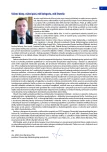Consensual therapeutic algorithm for treatment with insulin pump and continuous monitoring of glucose levels (in compliance with the indicative limitations as amended)
Authors:
Emil Martinka 1; Marián Mokáň 2; Vladimír Uličiansky 3; Silvia Dókušová 1; Miriam Čiljaková 6; Ingrid Dravecká 4; Michaela Mišaníková 1,2; Ľubomír Barák 5; Miroslav Paľko 4; Darina Návratová 6; Výbor Sds
Authors‘ workplace:
Národný endokrinologický a diabetologický ústav n. o. v Ľubochni
1; I. interná klinika Jesseniovej LF UK a UNM, Martin
2; Via medica, s. r. o., Košice
3; I. interná klinika LF UPJŠ a UN LP Košice
4; Detské diabetologické centrum SR pri I. detskej klinike DFNsP, Bratislava
5; V. interná klinika LF UK a UN Bratislava, Nemocnica Ružinov
6
Published in:
Forum Diab 2016; 5(2): 111-120
Category:
Guidelines
Overview
Administering of insulin by means of an insulin pump allows through pre-programmed repeated mini doses for individualization of insulin basal substitution for individual time periods of the day in hourly intervals, with a possible differentiation of U-Hour by 0.05 through to 0.01 U-Hour. This makes it possible to take into account and adjust therapeutic substitution of insulin to the requirements of physiological diurnal rhythm as well as to the changing daily needs, instantly or over the long-term, following from work or lifestyle related demands. The presented text describes a consensual therapeutic algorithm for treatment with an insulin pump and continuous monitoring of glucose levels in compliance with the indicative limitations as amended, formulated by the Committee of the Slovak Diabetes Society.
Key words:
individualized administration – insulin pump – insulin pen – continuous infusion – subcutaneous infusion
Sources
1. Aronson R, Cohen O, Conget I et al. OpT2mise: a randomized controlled trial to compare insulin pump therapy with multiple daily injections in the treatment of type 2 diabetes-research design and methods. Diabetes Technol Ther 2014; 16(7): 414–420. Dostupné z DOI: <http://dx.doi.org/doi:10.1089/dia.2013.0363>.
2. Bergenstal RM, Tamborlane WV, Ahmann A et al. Sensor-augmented pump therapy for A1C reduction (STAR 3) study: results from the 6-month continuation phase. Diabetes Care 2011; 34(11): 2403–2405.
3. Conget I, Battelino T, Giménez M et al. [SWITCH Study Group]. The SWITCH Study (Sensing With Insulin pump Therapy to Control HbA1c): Design and Methods of a Randomized Controlled Crossover Trial on Sensor-Augmented Insulin Pump Efficacy in Type 1 Diabetes Suboptimally Controlled with Pump Therapy. Diabetes Technol Ther 2011; 13(1): 49–54. Dostupné z DOI: <http://dx.doi.org/10.1089/dia.2010.0107>.
4. Deiss D, Bolinder J, Riveline JP et al. Improved Glycemic Control in Poorly Controlled Patients with Type 1 Diabetes Using Real-Time Continuous Glucose Monitoring. Diabetes Care 2006; 29(12): 2730–2732.
5. Garg SK, Brazg RL, Bailey TS et al. Reduction in duration of hypoglycemia by automatic suspension of insulin delivery: the in-clinic ASPIRE study. Diabetes Technol Ther 2012; 14(3): 205–209.
6. Hermanides J, Nørgaard K, Bruttomesso D et al. Sensor-augmented pump therapy lowers HbA(1c) in suboptimally controlled Type 1 diabetes; a randomized controlled trial. Diabet Med 2011; 28(10): 1158–1167. Dostupné z DOI: <http://dx.doi.org/10.1111/j.1464–5491.2011.03256.x>.
7. Kordonouri O, Pankowska E, Rami B et al. Sensor-augmented pump therapy from the diagnosis of childhood type 1 diabetes: results of the Paediatric Onset Study (ONSET) after 12 months of treatment. Diabetologia 2010; 53(12): 2487–2495. Dostupné z DOI: <http://dx.doi.org/10.1007/s00125–010–1878–6>.
8. Ly TT, Nicholas JA, Retterath A et al. Effect of sensor-augmented insulin pump therapy and automated insulin suspension vs standard insulin pump therapy on hypoglycemia in patients with type 1 diabetes: a randomized clinical trial. JAMA 2013; 310(12): 1240–1247.
9. Martinka E. Liečba diabetes mellitus 1. typu. In: Mokáň M, Martinka E, Galajda P. Diabetes mellitus a vybrané metabolické ochorenia. Vydavateľstvo P+M: Martin 2008. ISBN 9788096971398.
10. National Institute for Health and Care Excellence (NICE). Type 1 diabetes in adults: diagnosis and management. NICE guidelines [NG17] 2015. Dostupné z WWW: <https://www.nice.org.uk/guidance/ng17/resources/type-1-diabetes-in-adults-diagnosis-and-management-1837276469701>.
11. National Institute for Health and Care Excellence (NICE). Diabetes (type 1 and type 2) in children and young people: diagnosis and management. NICE guidelines [NG18]. 2015. Dostupné z WWW: <https://www.nice.org.uk/guidance/ng18>.
12. Nørgaard K, Scaramuzza A, Bratina N et al. [Interpret Study Group]. Routine sensor-augmented pump therapy in type 1 diabetes: the INTERPRET study. Diabetes Technol Ther 2013; 15(4): 273–280. Dostupné z DOI: <http://dx.doi.org/10.1089/dia.2012.0288>.
13. Pickup JC, Sutton AJ. Severe hypoglycaemia and glycaemic control in Type 1 diabetes: meta-analysis of multiple daily insulin injections compared with continuous subcutaneous insulin infusion. Diabet Med 2008; 25(7): 765–774.
14. Tamborlane WV, Beck RW, Bode BW et al. [Juvenile Diabetes Research Foundation Continuous Glucose Monitoring Study Group]. Continuous Glucose Monitoring and Intensive Treatment of Type 1 Diabetes. N Engl J Med 2008; 359(14): 1464–1476.
15. The PILGRIM study: in silico modeling of a predictive low glucose management system and feasibility in youth with type 1 diabetes during exercise. Diabetes Technol Ther 2014; 16(6): 338–347. Dostupné z DOI: <http://dx.doi.org/10.1089/dia.2013.0327>.
16. Raccah D, Sulmont V, Reznik Y et al. Incremental Value of Continuous Glucose Monitoring When Starting Pump Therapy in Patients With Poorly Controlled Type 1 Diabetes: The Real Trend Study. Diabetes Care 2009; 32(12): 2245–2250.
17. Ly TT, Nicholas JA, Retterath A et al. Analysis of glucose responses to automated insulin suspension with sensor-augmented pump therapy. Diabetes Care 2012; 35(7): 1462–1465.
Labels
Diabetology Endocrinology Internal medicineArticle was published in
Forum Diabetologicum

2016 Issue 2
Most read in this issue
- Consensual therapeutic algorithm for treatment with insulin pump and continuous monitoring of glucose levels (in compliance with the indicative limitations as amended)
- Consensual therapeutic algorithm for type 2 diabetes mellitus (in accordance with SPC, ADA/EASD indicative limitations and recommendations )
- Kidney transplantation and metabolic syndrome
- Iatrogenic hypoglycemia as a serious medical problem
